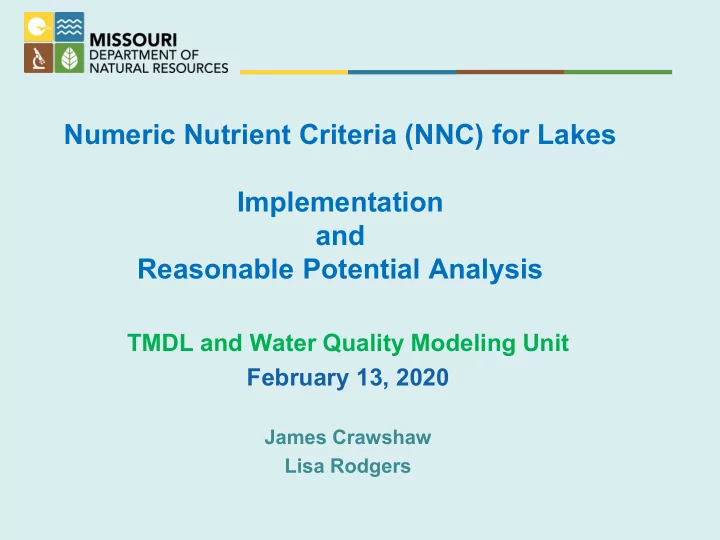

Numeric Nutrient Criteria (NNC) for Lakes Implementation and Reasonable Potential Analysis TMDL and Water Quality Modeling Unit February 13, 2020 James Crawshaw Lisa Rodgers
Reasonable Potential Analysis for Point Source Facilities Effluent Regulations at 10 CSR 20-7.015(9)(D)7 require: Statewide Monitoring for Nutrients. Point sources that have the design capacity of greater than one hundred thousand (100,000) gpd that typically discharge nitrogen and phosphorus shall collect and analyze influent and effluent samples for total phosphorus, ammonia, total kjeldahl nitrogen and nitrate plus nitrite… If the facility is determined to have reasonable potential to cause or contribute to violations lake nutrient criteria, point source facilities should expect effluent limits in future permits.
Plains Ozark Border Ozark Highlands
Lake Nutrient Criteria Lake Ecoregion Chl-a (µg/L = ppb) Plains 30 Ozark Border 22 Ozark Highland 15 Lake Ecoregion Total Phosphorus Total Nitrogen Chl-a (µg/L) (µg/L) (µg/L) Plains 49 843 18 Ozark Border 40 733 13 Ozark Highland 16 401 6 • Eutrophication-related mortality and morbidity for fish or other aquatic organisms • Exceedances of dissolved oxygen or pH criteria • Cyanobacteria counts >100,000 cells/mL (as algal toxins) • Observed shifts in aquatic diversity attributed to eutrophication • Excessive mineral turbidity (inorganic suspended solids) May-September
N + P = Chl-a = Algae Blooms
Reasonable Potential Analysis for Point Source Facilities Located in Lake Watersheds The purpose of this presentation is to show the technical process for determining whether facilities have the potential to cause or contribute to the Chl-a impairment in the receiving lake. Follow the process = the methods = the steps Understand how the steps lead to results
Reasonable Potential Analysis for Point Source Facilities Located in Lake Watersheds Step 1: Does the facility discharge nutrients directly to surface waters? Step 2: Do nutrients from facility effluent account for a substantial portion of nutrient loading in the lake watershed? Step 3: BATHTUB Model
Reasonable Potential Analysis Process Step 1: Does the facility discharge nutrients directly to surface waters? Eliminates facilities that: - Only land apply biosolids - Use effluent for irrigation - Have reported no discharge May-September for 3-5 years - Industrial facilities with trace concentrations in effluent Facilities that do not discharge nutrients to surface waters do not have reasonable potential to cause or contribute to the Chl-a impairment in the lake.
Reasonable Potential Analysis Process Step 2: Do nutrients from facility effluent account for a substantial portion of nutrient loading in the lake watershed? Estimate nonpoint source loading using a watershed model (e.g., STEPL or SWAT+) Using an Excel spreadsheet, compare the maximum potential nutrient contribution from each point source facility with the estimated nonpoint nutrient load for the watershed Facilities that account for <1% of nutrient contribution to the designated downstream point and that cumulatively account for <1% of nutrient contribution within the entire lake watershed are eliminated from further analysis Facilities that individually or collectively account for less than 1% of nutrient loading in the watershed do not have reasonable potential to cause or contribute to the Chl-a impairment in the lake.
Reasonable Potential Analysis Process Step 2 – Excel Spreadsheet Nonpoint TN and TP loads in pounds per year are entered based on watershed model (STEPL or SWAT+) estimates Point source facility characteristics are entered at maximum potential Facility Design Flow Maximum or mean of maximum TP entered for facilities that have consistently monitored TP, otherwise 30% of TSS permit limit is used for TP effluent estimate Permit Effluent Limits for Ammonia, or maximum recorded TN for facilities that have at least 3 years of monitored TN Estimated facility TN is equal to Ammonia + Nitrate/Nitrite using a default concentration of 20 mg/L Nitrate/Nitrite
Table 4. Discharging Municipal and Domestic Wastewater Treatment Facilities in the Watershed Map ID Permit Facility Design % TN to % TP to Distance to Expiration Flow Downstream Downstream Lake (GPD) Point Point (miles) 10 MO- Diggins (45,000) 1.72 0.26 33.6 3/31/2021 0129828 WWTF 136,000 Actual* 11 MO- Rogersville 960,000 2.29** 0.37* 16.2 6/30/2021 0102679 WWTF 12 MO- James 9,000 0.21 0.03 5.8 9/30/2020 0100315 Valley Farms Subdivision WWTF Total Domestic Wastewater Loading to <3.03% <0.47% the Lake Springfield Watershed *Analysis was based on actual flow using conservative TN and TP concentrations (no percent loss). **Percentage after percent loss per distance analysis.
Step 3 – BATHTUB Model Eight Lake Segments based on depth and flow direction – Upper Lake – Middle Lake – Lower Lake – Decker Branch – Upper Lindley – Shallow Lindley – Out Lindley Nineteen Tributaries – 12 Nonpoint Source subwatersheds – Pomme de Terre River and Lindley Creek Monitored Inflows – Five Point Source Inflows
Bolivar WWTF = No Reasonable Potential Wright City WWTF = Yes, Reasonable Potential
Facilities that are determined not to have reasonable potential to cause or contribute to lake impairments may still have permit effluent limits for nutrients due to downstream impairments.
Questions? Lisa Rodgers James Crawshaw Environmental Specialist Environmental Specialist TMDL-Modeling Unit TMDL-Modeling Unit Water Protection Program Water Protection Program 522-2552 751-2034 Lisa.Rodgers@dnr.mo.gov James.Crawshaw@dnr.mo.gov
Recommend
More recommend